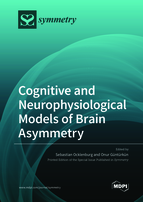Cognitive and Neurophysiological Models of Brain Asymmetry
A special issue of Symmetry (ISSN 2073-8994). This special issue belongs to the section "Life Sciences".
Deadline for manuscript submissions: closed (30 November 2021) | Viewed by 57526
Special Issue Editors
Interests: brain asymmetry; hemispheric asymmetries; handedness; language lateralization; genetics; neuroscience; neuroimaging; laterality; psychology; meta-analysis
Special Issue Information
Dear Collegues,
Asymmetry is an inherent characteristic of brain organization in both humans and other vertebrate species. It is evident on the behavioural, neurophysiological and structural level. Brain asymmetry underlies the organization of several cognitive systems, such as emotion, communication and spatial processing. Despite this ubiquity of asymmetries in the vertebrate brain, we are only beginning to understand the complex neuronal mechanisms underlying this interaction between hemispheric asymmetries and cognitive systems. Unfortunately, despite the vast amount of empirical studies on brain asymmetries, theoretical models that aim for mechanistic explanations are sparse in the field. Therefore, this Special Issue is aimed at highlighting empirically-based mechanistic models of brain asymmetry. Both empirical papers testing existing or new models as well as theoretical papers suggesting new models of brain asymmetry are welcomed for the Special Issue. Replication studies of existing empirical evidence for specific models are also encouraged. Both submissions covering research in humans or research in non-human model species are welcome.
Dr. Sebastian Ocklenburg
Prof. Dr. Onur Güntürkün
Guest Editors
Manuscript Submission Information
Manuscripts should be submitted online at www.mdpi.com by registering and logging in to this website. Once you are registered, click here to go to the submission form. Manuscripts can be submitted until the deadline. All submissions that pass pre-check are peer-reviewed. Accepted papers will be published continuously in the journal (as soon as accepted) and will be listed together on the special issue website. Research articles, review articles as well as short communications are invited. For planned papers, a title and short abstract (about 100 words) can be sent to the Editorial Office for announcement on this website.
Submitted manuscripts should not have been published previously, nor be under consideration for publication elsewhere (except conference proceedings papers). All manuscripts are thoroughly refereed through a single-blind peer-review process. A guide for authors and other relevant information for submission of manuscripts is available on the Instructions for Authors page. Symmetry is an international peer-reviewed open access monthly journal published by MDPI.
Please visit the Instructions for Authors page before submitting a manuscript. The Article Processing Charge (APC) for publication in this open access journal is 2400 CHF (Swiss Francs). Submitted papers should be well formatted and use good English. Authors may use MDPI's English editing service prior to publication or during author revisions.
Keywords
- neuroscience
- brain
- asymmetry
- laterality
- functional hemispheric asymmetries
- structural hemispheric asymmetries
- theoretical models







